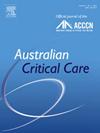识别障碍和促进治疗拥抱在儿科重症监护室:由理论领域框架指导的调查。
IF 2.7
3区 医学
Q2 CRITICAL CARE MEDICINE
引用次数: 0
摘要
目的:本研究的目的是描述卫生保健专业人员(HCPs)对儿科重症监护病房(PICU)治疗性拥抱(TC)的障碍和促进因素。背景:TC是预防/控制picu中疼痛、躁动、谵妄和镇静暴露的潜在干预措施。然而,它并没有被广泛实践。鉴于危重儿童TC的复杂性,PICU HCPs对障碍和促进因素的看法对实施和评估至关重要。方法:在理论领域框架的指导下,于2023年12月至2024年7月对PICU HCPs进行横断面调查。问题是根据患者的年龄组(12岁)和疾病的严重程度提出的。根据每个项目收到的回复数量,使用频率(百分比)对标称数据进行汇总。对于有5名或更多受访者的专业,进行了与专业角色和TC相关的项目的亚组分析。利用归纳和演绎内容分析分析自由文本响应。结果:受访者(n = 228)主要是女性(88.6%),护士(60.1%),医生(17.1%)或呼吸治疗师(11.8%)。大多数受访者(67.9%-86.4%,取决于患者年龄组)同意为所有PICU患者提供TC是可能的。然而,受访者报告很少(4.3%-52.6%)或从未(0.5%-35.6%)观察/参与TC,这取决于儿童年龄组,随着年龄组的增加,报告很少或从未的比例更大。在理论领域框架的所有14个领域中,确定了影响picu中TC实施的潜在决定因素。对患者安全、人员配备和缺乏支持性单位文化的担忧被认为是主要障碍。家庭参与和伙伴关系以及对积极后果的信念是关键的促进因素。结论:大多数PICU HCPs认为TC可以在所有危重患儿中实施。重要的障碍包括对安全、人员配备和缺乏拥抱支持文化的担忧。促进患者和家属的参与是支持实施这一干预措施的关键促进因素。本文章由计算机程序翻译,如有差异,请以英文原文为准。
Identifying barriers and facilitators to therapeutic cuddling in the paediatric intensive care unit: A survey guided by the theoretical domains framework
Objective
The objective of this study was to describe barriers and facilitators to paediatric intensive care unit (PICU) therapeutic cuddling (TC) perceived by healthcare professionals (HCPs).
Background
TC is a potential intervention to prevent/manage pain, agitation, delirium, and analgosedation exposure in PICUs. However, it is not widely practiced. Given the complexity of TC in critically ill children, PICU HCPs’ perspectives of barriers and facilitators are essential to inform implementation and evaluation.
Methods
A cross-sectional survey, guided by the Theoretical Domains Framework, was administered to PICU HCPs between December 2023 and July 2024. Items were asked based on age groups of patients (<1, 1–2, 3–4, 5–8, 9–12, and >12 years) and severity of illness. Nominal data were summarised using frequencies (percentage) based on the number of responses received per item. Subgroup analyses were conducted for professions with five or more respondents for items related to professional role and TC. Free-text responses were analysed utilising inductive and deductive content analysis.
Results
Respondents (n = 228) were predominantly women (88.6%), nurses (60.1%), physicians (17.1%), or respiratory therapists (11.8%). Most respondents (67.9%–86.4% depending on patient age group) agreed it was possible to provide TC to all PICU patients. However, respondents reported rarely (4.3%–52.6%) or never (0.5%–35.6%) observing/participating in TC, depending on child age group, with a larger proportion reporting rarely or never as age group increased. Potential determinants affecting the implementation of TC in PICUs were identified for all 14 domains of the Theoretical Domains Framework. Concerns about patient safety, staffing, and lack of supportive unit culture were identified as key barriers. Family engagement and partnership and beliefs about positive consequences were key facilitators.
Conclusions
Most PICU HCPs believe that TC can be implemented for all critically ill children. Important barriers include concerns about safety, staffing, and lack of a cuddling-supportive culture. Leveraging patient and family engagement is a key facilitator to support implementation of this intervention.
求助全文
通过发布文献求助,成功后即可免费获取论文全文。
去求助
来源期刊

Australian Critical Care
NURSING-NURSING
CiteScore
4.90
自引率
9.10%
发文量
148
审稿时长
>12 weeks
期刊介绍:
Australian Critical Care is the official journal of the Australian College of Critical Care Nurses (ACCCN). It is a bi-monthly peer-reviewed journal, providing clinically relevant research, reviews and articles of interest to the critical care community. Australian Critical Care publishes peer-reviewed scholarly papers that report research findings, research-based reviews, discussion papers and commentaries which are of interest to an international readership of critical care practitioners, educators, administrators and researchers. Interprofessional articles are welcomed.
 求助内容:
求助内容: 应助结果提醒方式:
应助结果提醒方式:


